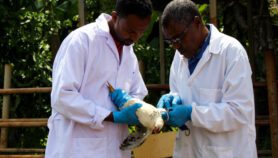By: Talent Ng’andwe
Send to a friend
The details you provide on this page will not be used to send unsolicited email, and will not be sold to a 3rd party. See privacy policy.
[HONG KONG] Researches from South-East Asia, a region that has recorded impressive increases in scientific research output over recent years, tend to collaborate with international colleagues more than the global average, according to a study.
Research output involving international collaboration ranges from around 30 per cent of the total research output in Malaysia to more than 90 per cent in Cambodia and Laos. This is considerably higher than the global average of less than 20 per cent.
The findings are based on an analysis by the British Council and SciVal Analytics, a research performance monitoring organisation, of academic articles published over the past five years and listed on Scopus bibliographic database.
The study looked at articles across six subject areas — agriculture, engineering, medicine, natural sciences, social sciences and the humanities, coming from selected countries within the ten-member Association of Southeast Asian Nations (ASEAN).
Most articles from the countries published in peer-reviewed international journals were the result of collaborative research led by China, France, Germany, Italy, Japan, the United Kingdom and the United States, according to Janet Ilieva, a senior education advisor at the British Council, who presented the study at a conference in Hong Kong last month (27–28 September).
She put the high rates of international collaboration down to the "relevance of the research".
"Research relevance is much wider if the research is carried out by several countries," Ilieva said. "As such, global problems can only be tackled by global research teams."
Ilieva told SciDev.Net that countries with small research capacity may depend on international collaborations to produce research.
For example, the study shows that Cambodia and Laos have the lowest research output out of eight countries studied (the other six were: Indonesia, Malaysia, Myanmar, Thailand, the Philippines, and Vietnam) but the highest international collaboration rate at more than 90 per cent.
Ilieva also encouraged ASEAN members to join forces and work more collaboratively among themselves, particularly in areas such as rice production and biodiversity.
Some of the highest impact collaborations involved research within the region, for example, between Indonesia and the Philippines; and Malaysia and Thailand.
Bernie Justimbaste, director of the Planning and Evaluation Service at the Philippines Department of Science and Technology, cited the importance of regional collaboration in food security, health, environment, climate change and disaster risk management.
Strengthening exchange programmes between regional researchers was one simple way of doing this, he said.
Ka Ho Mok, acting vice president of research and development at the Hong Kong Institute of Education, said international collaboration is important but he warned that inexperienced local researchers should exercise caution in their work because of intellectual property (IP) issues.
"I think IP is very important, [and] I think members with little experience should be cautious with it," Mok said.
Link to Janet Ilieva’s Hong Kong presentation
This article has been produced by SciDev.Net’s South-East Asia desk.













